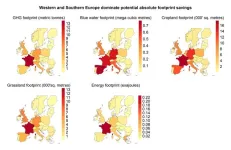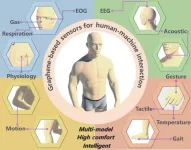(Press-News.org) This huge step forward in understanding how neurons communicate through extremely short proteins called neuropeptides will help scientists understand how our emotions and mental states are controlled, as well as widespread neuropsychiatric conditions like eating disorders, OCD and PSTD.
The map, which details 31,479 neuropeptide interactions between the worm’s 302 neurons, shows where each neuropeptide, as well as each receptor for those peptides, acts in the animal’s nervous system. Neuropeptides allow communication between neurons that are not immediately next to each other, so their networks can be thought of as a wireless connectome. A connectome is a map of the neurons which make up an organism’s brain and the detailed circuitry of neural pathways within it.
Researchers are making rapid progress in building connectomes for simple organisms, but until now, no-one had managed to build a map of a neuropeptide network in any animal.
Dr William Schafer and PhD student, Lidia Ripoll-Sánchez, both of the Medical Research Council Laboratory of Molecular Biology in Cambridge in the UK, led the work, together with Petra Vértes of Cambridge University and Isabel Beets from KU Leuven in Belgium. Their study is published in Neuron today.
The worm they studied is called C. elegans. It’s harmless, around 1mm long, and lives in soil. C. elegans has a very simple anatomy, but it shares many of the essential biological characteristics that are central problems of human biology.
Dr Schafer said:
"Neuropeptides and their receptors are among the hottest new targets for neuroactive drugs. For example, the diabetes and obesity drug Wegovy targets the receptor for the peptide GLP-1. But the way these drugs act in the brain at the network level is not well-understood.
“The structure of neuropeptide networks suggests that they may process information in a different way to synaptic networks. Understanding how this works will not only help us understand how drugs work but also how our emotions and mental states are controlled.
“The idea of mapping these wireless networks has been one of our goals for a long time, but only now have the right combination of people and resources come together to make this actually possible.”
Neuropeptides play a critical role in lasting biological responses. These diverse neuropeptides play important roles in mood, sexual behaviour, learning and memory, sleep and addiction. They function throughout the nervous system, but can also act on other types of tissue as hormones. Oxytocin is one example: it acts on various circuits in the brain that affect bonding between parents and children, but it also causes contraction of the muscles of the uterus during childbirth. Even when neuropeptides act in the brain, they can allow communication between neurons that are not connected by the physical junctions, called synapses, used by classical neurotransmitters.
Since most neurons seem to make both neuropeptides and neuropeptide receptors, the communication pathways formed by neuropeptides make up large neural networks. These networks are extensive, complex, and critical to the functioning of the brain. As such, they are important for understanding the neuronal basis of behaviour.
Ripoll-Sánchez said:
“Basic mechanisms of neuropeptide signaling are shared in all animals: neuropeptides are released from dense core vesicles in cells and diffuse to neurons unconnected to the releasing cell by wired synapses.
“The worm’s nervous system is anatomically small, but at the molecular level its neuropeptide systems are highly complex, showing significant parallels to larger animals, and its synaptic connectome shows many features that are conserved in bigger brains. We expect the neuropeptide connectome of C. elegans will serve as a prototype to understand wireless signaling in larger nervous systems.”
The researchers built the map by combining biochemical, anatomical and gene expression datasets, using them to determine which neurons can communicate with each other using specific neuropeptide signals. Once they built this network, they used graph theory to analyse its structure and identify key topological features as well as neurons with important roles in linking different parts of the network.
As well as generating the first comprehensive map of neuropeptide signaling in a whole animal, the researchers found that the wireless neuropeptide network in C. elegans has a different structure from wired connectomes. They are denser, more decentralised, and have different key neurons, or hubs. The network also connects parts of the nervous system that are isolated from the wired synaptic connectome.
Jo Latimer, Head of Neurosciences and Mental Health at the Medical Research Council, said:
“This is another exciting and significant body of work by colleagues at the MRC Laboratory of Molecular Biology and others, adding to the connectome work of LMB researchers earlier this year. Not only have they worked out which neuropeptides act where in the animal’s nervous system, they have discovered that the network is complex, but clearly organised, with an information processing circuit within it. This is a further important step forward in understanding how brains and nervous systems work, and this increased understanding may have the potential to lead to the future development of targeted therapies for a range of conditions.”
The next step will be to see whether the principles by which neuropeptide networks in worms are organised also apply in bigger brains. The researchers are currently working with other collaborators to map wireless neuropeptide networks in animals such as fish, octopuses, mice, and even humans.
ENDS
Reference
Lidia Ripoll-Sánchez, Jan Watteyne, HaoSheng Sun, Robert Fernandez, Seth R Taylor, Alexis Weinreb, Barry L Bentley, Mark Hammarlund, David M Miller III, Oliver Hobert, Isabel Beets, Petra E Vértes, William R Schafer, The neuropeptidergic connectome of C. elegans, Neuron [published online on 6 November 2023, with issue publication on 15 November 2023]
For an embargoed copy of the study and visuals, please see https://cloud.mrc-lmb.cam.ac.uk/s/K4NtKsjfpibkPWS
The study was funded by the Medical Research Council, as well as the European Research Council and the National Institutes of Health
After this article is published, it will be available on the Neuron website and ScienceDirect
Contact details
To arrange to speak to Dr William Schafer and/or Lidia Ripoll-Sánchez, please contact Tamera Jones, Senior Media and Communications Manager, Communications and Public Engagement Team, UK Research and Innovation, 07342 025443, tamera.jones@ukri.org
Notes to editors
The Medical Research Council is at the forefront of scientific discovery to improve human health. Founded in 1913 to tackle tuberculosis, the MRC now invests taxpayers’ money in some of the best medical research in the world across every area of health. Thirty-three MRC-funded researchers have won Nobel prizes in a wide range of disciplines, and MRC scientists have been behind such diverse discoveries as vitamins, the structure of DNA and the link between smoking and cancer, as well as achievements such as pioneering the use of randomised controlled trials, the invention of MRI scanning, and the development of a group of antibodies used in the making of some of the most successful drugs ever developed. Today, MRC-funded scientists tackle some of the greatest health problems facing humanity in the 21st century, from the rising tide of chronic diseases associated with ageing to the threats posed by rapidly mutating micro-organisms. www.ukri.org/councils/mrc/
MRC Laboratory of Molecular Biology
The Medical Research Council (MRC) Laboratory of Molecular Biology (LMB) is one of the world's leading research institutes. Discoveries and inventions developed at the LMB, for example DNA sequencing and methods to determine the structure of proteins, have revolutionised all areas of biology. Its scientists work to advance understanding of biological processes at the molecular level. This information will help us to understand the workings of complex systems, such as the immune system and the brain, and solve key problems in human health. http://www2.mrc-lmb.cam.ac.uk/. The MRC is part of UK Research and Innovation (UKRI). Follow the MRC LMB on Twitter @MRC_LMB
END
First wireless map of worm’s nervous system revealed
Researchers have built the first ever map showing how every single neuron in the nervous system of a tiny worm communicates wirelessly
2023-11-06
ELSE PRESS RELEASES FROM THIS DATE:
Epidemiology and genetics of clonal hematopoiesis, a premalignant hematopoietic stem cell condition
2023-11-06
Reykjavik 6. November 2023.
Epidemiology and Genetics of Clonal Hematopoiesis, a Premalignant Hematopoietic Stem Cell Condition
A comprehensive new study from deCODE genetics, a subsidiary of Amgen, published today in Nature Genetics, provides insights into the epidemiology and somatic and germline genetics of clonal hematopoiesis. Whole genome sequence data from Iceland and the UK Biobank, combined with a unique somatic mutation Barcoding strategy, was used to investigate clonal hematopoiesis at the population scale.
Clonal hematopoiesis is a condition that arises when a single clonal lineage ...
Neighborhood deprivation and DNA methylation and expression of cancer genes in breast tumors
2023-11-06
About The Study: In this study of 185 women with breast cancer, high neighborhood deprivation was associated with differences in tissue DNA methylation and gene expression among Black women. These findings suggest that continued investment in public health interventions and policy changes at the neighborhood level may help to remedy biological alterations that could make minoritized populations more susceptible to chronic diseases.
Authors: Stefan Ambs, Ph.D., of the National Cancer Institute in Bethesda, ...
UC Irvine-led science team shows how to eat our way out of the climate crisis
2023-11-06
Irvine, Calif., Nov. 6, 2023 — Agriculture is one of the hardest human activities to decarbonize; people must eat, but the land-use practices associated with growing crops account for roughly a quarter of global greenhouse gas emissions. Researchers at the University of California, Irvine and other institutions evaluate a new solution to this problem, one that eliminates farms altogether.
In a study published today in Nature Sustainability, the UCI-led team of scientists assess the potential for widescale synthetic production of dietary fats through chemical and biological processes. The raw materials for this method are the same as those used by ...
Keeping an eye on the regions when it comes to climate change
2023-11-06
Keeping an eye on the regions when it comes to climate change
Up to now, the results of climate simulations have sometimes contradicted the analysis of climate traces from the past. A team led by the physicist Thomas Laepple from the Alfred Wegener Institute in Potsdam and the climatologist Kira Rehfeld from the University of Tübingen has therefore brought together experts in climate models and climate tracks to clarify how the discrepancies come about. The surprising result has now been published in the journal Nature Geoscience: in a way, both sides ...
Abortion bans linked to increase in children entering foster system, researchers find
2023-11-06
BOSTON – In June 2022, the U.S. Supreme Court overruled Roe v. Wade, effectively ending 50 years of federal protections to abortion care. As of October 2023, twenty-six states have since enacted laws to ban or restrict abortion access, with 14 states completely banning the procedure. Today, an estimated 25 million American women of childbearing age, or about one third of women ages 15 to 45, live in areas where abortion care is severely restricted. Historically, many states were able to restrict access to abortion even before 2022 through Targeted Regulation of Abortion Providers (TRAP) laws; these laws decrease ...
A blood test shows MS worsening 1 to 2 years before it happens
2023-11-06
Multiple sclerosis patients whose blood tests reveal elevated NfL, a biomarker of nerve damage, could see worsening disability one to two years later, according to a new study spearheaded by researchers at UC San Francisco.
The study is the first to quantify the timeframe preceding disability worsening in which injury to the central nervous system takes place, said co-first author Ahmed Abdelhak, MD, of the UCSF Department of Neurology and the Weill Institute for Neurosciences.
Almost 1 million Americans ...
Major study validates Owkin’s best in class AI diagnostic for colorectal cancer biomarker aimed at optimizing patient access to immunotherapy
2023-11-06
Article in Nature Communications demonstrates that with 96% sensitivity, AI diagnostic MSIntuit™ CRC can rule out almost half of the MSS population of colorectal cancer patients unlikely to respond to checkpoint inhibitor therapy from additional screening.
Such AI-enabled solutions have the potential to improve lab efficiency, addressing global pathology shortages and reducing testing burden to match the right patients to the right therapies.
Paris and New York., 6 Nov 2023 – In a peer-reviewed study published today in Nature Communications, a team of scientists ...
Food waste prevention in Europe can generate major footprint savings
2023-11-06
New research shows that European food consumption draws unnecessarily excessively on global resources, which is why researchers are calling for political action. Many of the foods that are consumed in Europe are produced in countries outside Europe. Food loss – and waste later in the chain, (read more on waste terms below) – occurs along the food supply chain, from the primary agricultural sector in Europe or rest of the world, until it feeds mouths in Europe.
“Halving Europe’s food loss and waste, together with a redistribution of global food resources, could solve the challenges of food shortages in the ...
NIH grant expands UIC brain bank into citywide effort to study epilepsy, brain cancer
2023-11-06
A new virtual brain bank spanning five Chicago academic medical centers and led by University of Illinois Chicago will create a powerful new resource for clinical care and research on epilepsy, brain tumors and neurological disorders.
A $5 million grant from the National Institutes of Health will create a network of brain tissue research at UIC, Northwestern University, Lurie Children’s Hospital, Rush University and University of Chicago. The institutions will utilize a data platform developed at UIC called INTUITION that combines tissue data with clinical, functional, genetic and 3D imaging information to assist clinicians treating patients and help researchers better understand ...
Carbon-based sensors are poised to facilitate a seamless human-machine interface
2023-11-06
Interaction between machines and humans is paramount to the development of the new technologies of the metaverse, which are designed to augment the human experience through cloud computing and extended reality (XR). Graphene, a two-dimensional carbon material, has emerged as an ideal candidate for wearable sensor technology, paving the way for a new era of seamless human-machine interaction (HMI).
A team of material scientists led by Tian-Ling Ren from Tsinghua University in Beijing, China recently outlined the state of graphene-based HMI sensor technology ...
LAST 30 PRESS RELEASES:
Longest observation of an active solar region
Why nail-biting, procrastination and other self-sabotaging behaviors are rooted in survival instincts
Regional variations in mechanical properties of porcine leptomeninges
Artificial empathy in therapy and healthcare: advancements in interpersonal interaction technologies
Why some brains switch gears more efficiently than others
UVA’s Jundong Li wins ICDM’S 2025 Tao Li Award for data mining, machine learning
UVA’s low-power, high-performance computer power player Mircea Stan earns National Academy of Inventors fellowship
Not playing by the rules: USU researcher explores filamentous algae dynamics in rivers
Do our body clocks influence our risk of dementia?
Anthropologists offer new evidence of bipedalism in long-debated fossil discovery
Safer receipt paper from wood
Dosage-sensitive genes suggest no whole-genome duplications in ancestral angiosperm
First ancient human herpesvirus genomes document their deep history with humans
Why Some Bacteria Survive Antibiotics and How to Stop Them - New study reveals that bacteria can survive antibiotic treatment through two fundamentally different “shutdown modes”
UCLA study links scar healing to dangerous placenta condition
CHANGE-seq-BE finds off-target changes in the genome from base editors
The Journal of Nuclear Medicine Ahead-of-Print Tip Sheet: January 2, 2026
Delayed or absent first dose of measles, mumps, and rubella vaccination
Trends in US preterm birth rates by household income and race and ethnicity
Study identifies potential biomarker linked to progression and brain inflammation in multiple sclerosis
Many mothers in Norway do not show up for postnatal check-ups
Researchers want to find out why quick clay is so unstable
Superradiant spins show teamwork at the quantum scale
Cleveland Clinic Research links tumor bacteria to immunotherapy resistance in head and neck cancer
First Editorial of 2026: Resisting AI slop
Joint ground- and space-based observations reveal Saturn-mass rogue planet
Inheritable genetic variant offers protection against blood cancer risk and progression
Pigs settled Pacific islands alongside early human voyagers
A Coral reef’s daily pulse reshapes microbes in surrounding waters
EAST Tokamak experiments exceed plasma density limit, offering new approach to fusion ignition
[Press-News.org] First wireless map of worm’s nervous system revealedResearchers have built the first ever map showing how every single neuron in the nervous system of a tiny worm communicates wirelessly





